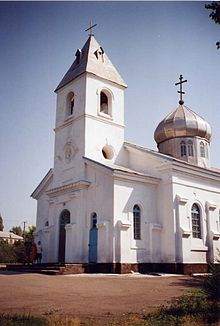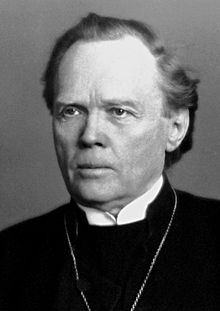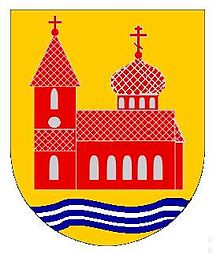Staroschwedske
Staroschwedske ( Ukrainian Старошведське , formerly Werbiwka / Вербівка; Swedish Gammalsvenskby , German historically Old Sweden Village ) was a village and is today the northeastern part of the municipality in the municipality of Smijiwka , which is located in the southern Ukrainian Oblast of Kherson . This was founded by Swedish settlers in 1782. Even today, a small minority of Swedes still live in the village, who also speak the Swedish language. There is also a parish of the German Lutheran Church in Ukraine .
history
founding
The Swedish founders of the village were originally Estonian Swedes from the Röicks district (today: Reigi ) on the Baltic island of Dagö ( Hiiumaa ). This area, which has belonged to Estonia since 1918 , was owned by the Teutonic Order since 1237 , became Danish in 1560, Swedish in 1582 and became part of the Russian Empire in the Northern War in 1721 .
The once tax-free Dagö Swedes were burdened with more and more services over time. In Russian times, individual undesirable farmers were given away, sold or exchanged for horses and hunting dogs, which led to complaints at the Judicial College in St. Petersburg in 1779 and to an agreement on February 27, 1780 in which the farmers were granted freedom, but to March 1781 all positions were terminated.
On March 8, 1781, Catherine the Great issued an ukase in which she gave the order to the Swedish farmers from the Hohenholm estate , the number of which extends to a thousand, to transplant themselves to the Krons lands in the Neureussian governorate and them to be included in the number of Krons-Collonists according to the ordinance there
Under promising privileges, such as 60 desjatines (approx. 65 ha) of land per family, tax exemption for four years, wood for building houses and furniture at the expense of the crown, seeds for sowing, a colony of their own , permission to build their own church and hold their own pastor, they should be allowed to live as free farmers in what is now southern Ukraine, which was then just conquered by the Russian Empire.
During the more than 2000 km long walk to their new homeland, which lasted from August 1781 to May 1782, only 535 of the approximately 1000 inhabitants who left New Russia arrived. After arriving in the steppe area, they settled about 15 km east of the city of Beryslav on the banks of the Dnieper . However, they found no trace of the originally promised houses. As a result, an even larger group (336) lost their lives, so that in March 1783 only 135 people were still alive.
Until the Russian Revolution
As a result, German colonists came to this region who founded three villages near Gammalsvenskby between 1804 and 1806. Schlangendorf and Mühlhausendorf were Lutheran and Klosterdorf Catholic. In 1915 these places were united in the Ukrainian community Smijiwka , whose name is derived from the German village Schlangendorf.
As the German colonists were more numerous, it was very difficult for the Swedes to preserve their culture in the years that followed, as many priests and teachers were Germans. There were also conflicts between Germans and Swedes about free arable land, which was becoming increasingly scarce due to immigration.
Even if the inhabitants of the village had no contact with their Swedish homeland for about a century, they were still able to preserve their traditions and the Lutheran faith. In addition, they also preserved an old Swedish dialect in this Swedish language island .
At the end of the 19th century contacts were made with the Swedish homeland again. Money was raised in Sweden and Finland, with which a Swedish church could be built, which opened in 1885. The village was visited relatively often by Swedes and villagers were even able to subscribe to Swedish newspapers. In the course of the First World War , however, all communication channels were cut off again.
Interwar period
After the withdrawal of the German troops in early September 1918 and the civil war , the Sovietization of life and culture also reached the Dnieper.
During the struggle against the “exploiters” ( kulaks ), the peasant upper class, more than 40 farmers in Gammalsvenskby were classified as kulaks and disenfranchised. As "Lischenzy" (people without rights) they had no right to vote and were imposed individual taxes at high rates, which ruined their independent existence. If a citizen had paid his tax, he was immediately imposed a tax 3 to 5 times higher.
A 1923 decree stipulated that the land should be re-measured. Every wealthy farmer (kulak) owned 60 desjatins (1 desjatins ≈ 1.1 ha), with a few exceptions. In southern Ukraine, however, the new standard was less than one desjatine per family member.
As a result of this rescheduling, 55 families were given permission to establish the daughter colony Nysvenskby (Neuschwedendorf) 18 km northwest of Gammalsvenskby.
A second daughter colony, Svenskåker (Swedish Field), between Gammalsvenskby and Nysvenskby was never really inhabited. The settlers stayed there during the harvest, but then mostly lived in Gammalsvenskby.
The renaming of the places was also part of the Sovietization, especially if the old names could be associated with the previous regime. Altschwedendorf was officially renamed Gammalsvenskby in 1926, Röd Svenskby (Red Swedish Village) in 1931 and Staroshvedskoe from 1934.
When the villagers were put under increasing pressure by the authorities, they relied on the "Law on the Right to Self-Determination of National Minorities in the USSR " and demanded to be able to leave the Soviet Union to settle in Sweden, the home of their ancestors, to settle down. There her cause was supported by a Swedish patriotic movement and by Archbishop Nathan Söderblom .
On July 22, 1929, the Swedish-born villagers who had received the exit permit were brought downriver by two steamers to Cherson , where the Swedish Red Cross had chartered the Turkish cargo ship Firuzan for the crossing to Constanța in Romania . From there they continued by train via Sinaia , Brașov , Lőkösháza , Budapest , Vienna , Passau and Stralsund to Sassnitz , where they took the ferry from Germany to Sweden. On August 1, 1929, 885 people set foot on Swedish soil. The desire to be able to settle down together in their own village soon had to be given up with great disappointment.
19 families with a total of 94 people decided to emigrate to Canada in 1930 , where some emigrants from Gammalsvenskby had already settled. Eleven families moved to Meadows, 25 miles west of Winnipeg , Manitoba , and the others moved to Van Horn just outside Winnipeg. It wasn't easy to get started in Canada, so six families returned to Sweden in 1935/36.
The majority of the villagers who stayed in Sweden settled on Gotland Island in 1930 , the rest in the historic provinces of Västergötland and Småland . Around 250 returned to Gammalsvenskby, where they founded the small collective farm Sjvedkompartija together with members of the Swedish Communist Party .
Stalinist Terror and World War II
After the village was also affected by the severe famine in the course of forced collectivization in 1932/33 , in which many in this village also lost their lives, some wanted to return to Sweden. A list of villagers willing to emigrate was drawn up. This resulted in about 20 being arrested by the GPU secret police . As a result, other villagers lost their lives in the wake of the Stalinist terror.
When the village was conquered by the Germans in August 1941, they were welcomed as liberators. With their withdrawal in 1943, the Swedes were resettled together with the German residents. Most of them came to Krotoschin in the Warthegau , where they ultimately came under Soviet occupation. About 150 of the villagers were arrested and taken to gulags . They were only allowed to return to Gammalsvenskby in 1947. Others managed to return straight to Gammalsvenskby.
present
With the dissolution of the Soviet Union, contacts between the villagers and Sweden have been revived. So the villagers u. a. Support from the Swedish Church. Today the village has around 150-200 inhabitants of Swedish descent, but only a few speak the old Swedish dialect fluently. At times a Swedish teacher taught Swedish in the school. In addition, some research was carried out in the community.
Sons and daughters of the place
- Kristoffer Thomasson Hoas (1877–1941), sexton teacher from 1896 to 1922 and pastor from 1922 to 1929, organized the repatriation of the residents of Gammalsvenskby
See also
literature
- Jörgen Hedman: Gammalsvenskby, The true story of the Swedish settlement in the Ukraine.
- Karl Friedrich Wilhelm Rußwurm : Eibofolke or the Swedes on the coast of Esthland and on Runö , an ethnographic study with documents, topography and history, first part. Reval 1855.
- Piotr Wawrzeniuk, Julia Malitska: The Lost Swedish Tribe: Reapproaching the history of Gammalsvenskby in Ukraine. Södertörn University, Elanders, Stockholm 2014, ISBN 978-91-86069-85-8 ( English ).
Web links
- The Svenskbyborna Society in Sweden (Swedish)
- History of the place ( Memento from February 17, 2011 in the Internet Archive )
- Revision list of the residents of Gammalsvenskby from 1808 (last accessed on August 2, 2014)
- Ethnographic map of West-Ehstland designed by C. Rußwurm
- List of emigrants from July 24, 1929
Individual evidence
- ↑ a b Carl Friedrich Wilhelm Russwurm: Eibofolke or the Swedes on the coasts of Ehstland and on Runö, first part. Reval 1855, p. 94.
- ↑ a b Carl Friedrich Wilhelm Russwurm: Eibofolke or the Swedes on the coasts of Ehstland and on Runö, first part. Reval 1855, p. 249 f.
- ↑ Jörgen Hedman: Gammalsvenskby, The true story of the Swedish settlement in the Ukraine , p. 8.
- ^ Jörgen Hedman: Gammalsvenskby, The true story of the Swedish settlement in the Ukraine , p. 11.
- ↑ Jörgen Hedman: Gammalsvenskby, The true story of the Swedish settlement in the Ukraine , p. 32.
Coordinates: 46 ° 52 ' N , 33 ° 35' E




